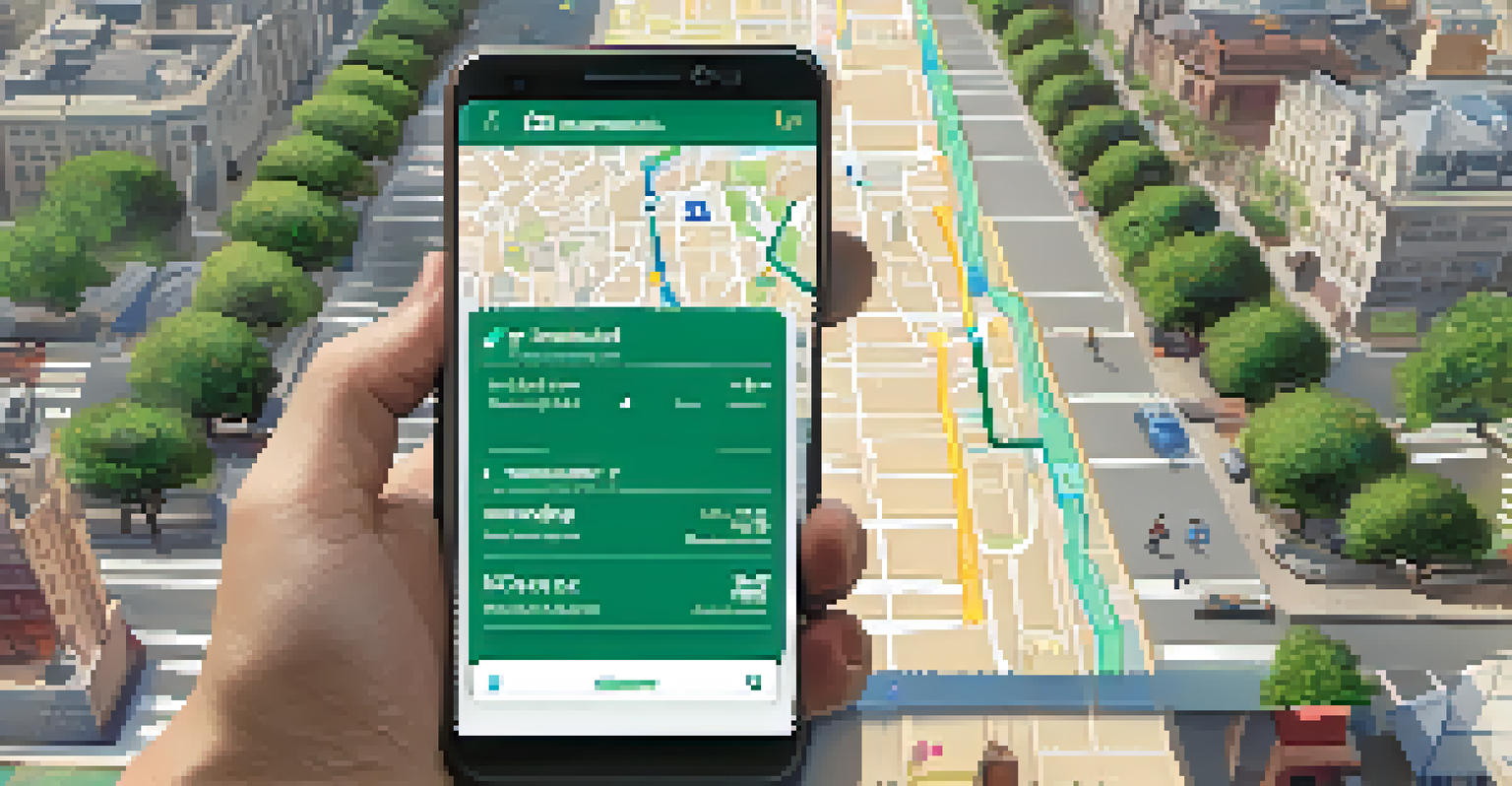Crowdsourcing Accessibility Solutions: Community Innovations

Understanding Crowdsourcing and Accessibility Innovations
Crowdsourcing is a powerful concept where a large group of people contribute ideas, resources, or services to solve a problem. In the context of accessibility, it allows communities to come together and develop innovative solutions that cater to individuals with disabilities. This collaborative approach harnesses the unique perspectives and experiences of many, paving the way for more inclusive designs.
Alone we can do so little; together we can do so much.
For example, a community might identify the need for tactile maps in public spaces to assist visually impaired individuals. By gathering input from local residents, developers, and accessibility experts, they can create a more effective and user-friendly product that meets everyone's needs. This illustrates how collective brainstorming can lead to breakthroughs that might not emerge from traditional methods.
Ultimately, understanding the intersection of crowdsourcing and accessibility is crucial for fostering innovation. The more diverse the contributors, the richer the solutions, ensuring that they are practical and relevant for the intended users.
Success Stories: Communities Making a Difference
Numerous communities around the globe have successfully implemented crowdsourced accessibility projects that have dramatically improved lives. One standout example is a mobile app developed by a group of volunteers that helps users find wheelchair-accessible routes in cities. By pooling their knowledge and resources, they were able to create a tool that empowers individuals with mobility challenges to navigate their surroundings with confidence.

Another inspiring case is that of a local library that hosted a hackathon to develop solutions for hearing-impaired patrons. Participants collaborated to create innovative technologies, such as real-time captioning and sign language interpretation services, making library resources more accessible. These types of events not only generate practical solutions but also foster community spirit and awareness.
Crowdsourcing Enhances Accessibility
By uniting diverse perspectives, crowdsourcing fosters innovative solutions that address the needs of individuals with disabilities.
These success stories highlight the potential of grassroots movements in addressing accessibility challenges. When communities unite, they can create impactful changes that resonate far beyond their immediate environment, inspiring others to follow suit.
Technology's Role in Crowdsourcing Accessibility Solutions
Technology is a pivotal player in the crowdsourcing landscape, enabling efficient collaboration among diverse groups. Online platforms and social media have made it easier than ever for individuals to share ideas, solicit feedback, and gather support for innovative accessibility initiatives. With just a few clicks, people can connect with others who share their passion for making the world more accessible.
The greatness of a community is most accurately measured by the compassionate actions of its members.
For instance, platforms like GitHub allow developers to collaborate on open-source projects aimed at improving accessibility features in software and applications. By inviting contributions from a global pool of talent, these projects can evolve rapidly and incorporate diverse perspectives that enhance their effectiveness. This technological synergy can lead to solutions that are not only innovative but also widely adopted.
Moreover, technology also enables real-time data collection and analysis, allowing communities to assess the impact of their initiatives. By tracking user experiences and gathering feedback, they can continuously improve their offerings, ensuring that their accessibility solutions remain relevant and effective.
Engaging Stakeholders for Meaningful Impact
Engaging stakeholders is essential for creating successful crowdsourcing initiatives in accessibility. This includes not just individuals with disabilities, but also local businesses, government agencies, and advocacy groups. By bringing together these diverse voices, communities can identify unmet needs and collaboratively develop solutions that are truly impactful.
For example, when designing a new public transit system, city planners can host forums where community members, including those with disabilities, provide input on their experiences and suggestions. This ensures that the final design is not only functional but also user-friendly for everyone. Such inclusive practices foster a sense of ownership and encourage active participation from all stakeholders.
Community Engagement Drives Change
Engaging stakeholders, including those with disabilities, is crucial for creating effective and impactful accessibility solutions.
Ultimately, meaningful engagement leads to better solutions and a stronger community. When everyone feels heard and valued, it paves the way for innovative transformations that address accessibility challenges head-on.
Challenges in Crowdsourcing Accessibility Solutions
While crowdsourcing has immense potential, it also comes with its own set of challenges. One major hurdle is ensuring that all voices are heard, particularly those of marginalized groups who may not have the same access to resources or platforms. It's crucial for organizers to actively reach out and create opportunities for these voices to be included in the conversation.
Additionally, there's the risk of 'idea overload,' where too many suggestions can lead to confusion and a lack of direction. To combat this, it's important to establish clear goals and criteria for evaluating proposed solutions. By doing so, communities can streamline the process and focus on the most viable options.
Lastly, sustaining momentum is another challenge. Once a project is launched, keeping participants engaged and motivated over time can be difficult. Regular updates, celebrating milestones, and recognizing contributions can help maintain enthusiasm and commitment among community members.
Future Trends in Crowdsourcing Accessibility Solutions
Looking ahead, the future of crowdsourcing in accessibility is bright, with emerging technologies and trends poised to drive innovation. One exciting development is the increasing use of artificial intelligence (AI) to analyze data and suggest tailored solutions for individuals with disabilities. By leveraging AI, communities can develop more personalized and effective accessibility measures.
Another trend is the growing emphasis on sustainable and inclusive design principles. As awareness of accessibility issues continues to rise, more organizations are committing to incorporating these principles from the outset of their projects. This proactive approach not only benefits individuals with disabilities but also enhances the overall user experience for everyone.
Technology Fuels Collaboration
Online platforms and AI play a significant role in enabling collaboration, streamlining efforts, and enhancing the effectiveness of accessibility initiatives.
Additionally, as remote work and virtual collaboration become more common, crowdsourcing initiatives will likely expand beyond geographic boundaries. This interconnectedness offers a wealth of perspectives and ideas, enriching the design process and leading to innovative solutions that can be implemented on a larger scale.
Creating a Culture of Accessibility through Crowdsourcing
Fostering a culture of accessibility is essential for long-term success in crowdsourcing initiatives. This involves not only implementing solutions but also instilling values of inclusivity and empathy within the community. By educating individuals about the importance of accessibility, communities can create a supportive environment where everyone feels empowered to contribute.
For instance, workshops and seminars can be organized to raise awareness about the challenges faced by individuals with disabilities. By sharing personal stories and experiences, these events can foster understanding and inspire collective action. When people see the impact of their contributions, it strengthens their commitment to the cause.

Ultimately, creating a culture of accessibility is an ongoing process that requires dedication and collaboration. By continuously engaging community members and celebrating successes, we can build a more inclusive society where everyone has the opportunity to thrive.
Conclusion: The Power of Community in Accessibility Solutions
In conclusion, crowdsourcing accessibility solutions is a powerful approach that taps into the collective intelligence of communities. By engaging diverse stakeholders, leveraging technology, and fostering a culture of inclusivity, we can create innovative solutions that enhance the lives of individuals with disabilities. The stories of success and collaboration serve as a testament to what can be achieved when we work together.
As we look to the future, it's essential to remain committed to these principles and continue exploring new ways to harness the power of community. The challenges are significant, but the potential for positive change is even greater. By prioritizing accessibility, we open doors for everyone to participate fully in society.
Let us embrace the spirit of collaboration and innovation, ensuring that accessibility solutions are not just an afterthought but a fundamental aspect of our communities. Together, we can pave the way for a more inclusive and equitable world.